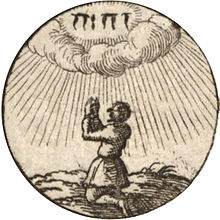Liturgical calendar (Lutheran)
However, Christian denominations have historically observed other festivals which commemorate events in the life of Jesus or of significant individuals in the history of the Church.
[2] Because Easter varies in date each year based on the vernal equinox and the phases of the moon, it is called a moveable feast (see: Computus).
[5] The Festivals are Nativity, Epiphany, the Baptism of our Lord, the Transfiguration, the Annunciation, Palm Sunday, Easter, the Ascension, Pentecost, Holy Trinity, All Saints, and Christ the King.
[11] This is abrogated for patronal festivals (that is, the day commemorating the saint or event for which a congregation is named) provided that they do not take place in Lent, Advent, or Easter, in which case they must also be transferred to the next convenient weekday.
[14] The schedule of commemorations within the ELCA has been specifically designed so that there is at least one person on the calendar from each century so as to emphasize the continuity of Christian tradition.
[16] The service books of Lutheran Churches designate specific colors for events which are listed on the liturgical calendars and the seasons which are a part of the Temporal Cycle.
It is also optional for use during Advent, though blue is the preferred color for this season because of its hopeful connotations rather than the penitential character implied by purple and its association with Lent.
In the case of the Lutheran churches, most of the saints' days were removed (with the exception of some New Testament personages), though the basic temporal cycle of the calendar remained more or less intact.
The church year continued to begin with the First Sunday of Advent (which was still fixed based on the traditional formula), and many of the festivals surrounding Christmas (St. Stephen, St. John, the Holy Innocents) remained in place, even if they were often ignored.
[22] Epiphany also continued to be celebrated as the visit of the Magi, though Martin Luther preferred to commemorate the baptism of Christ.
Good Friday, while kept with solemnity, was often a celebration of Holy Communion, thus less somber than the contemporary Roman Catholic Church.
St. Ansgar was commemorated in Halberstadt and Nordligen with a special thanksgiving service on the Sunday after 3 February, no doubt because of the saint's historic connection to the area.
[25] Festivals of the apostles and evangelists were also found on Lutheran calendars of the era, but were not always observed if they fell on a day other than Sunday.
[25] Some of the Marian festivals, notably the Nativity of Mary (September 8) and her Assumption (August 15) were retained by Luther whereas the feasts of her conception and presentation in the Temple were suppressed “because they were judged to have no scriptural or dogmatic interest.”[21] When the Lutheran Reformation was brought to Sweden from Germany via Denmark after the election of Gustav Vasa in 1523, the movement from the start had its own distinct characteristics.
[27] The Swedish Mass draws from a number of different sources, though Luther's Formulae Missae is apparent in regards to the Eucharistic structure.
In large part, the Swedish liturgy retained “vestments, altars and frontals, gold and silver chalices and patens” and many other “popish” customs.
[29] Following Laurentius’ death in 1573, King John III embarked on a separate, though similar, religious policy more conciliatory towards Catholicism.
Most included events such as the Annunciation or persons such as Saint Paul, these days often went unobserved despite scrupulous attention to the temporal cycle.
The Pennsylvania Ministerium composed the first liturgy for North America, including its calendar along somewhat minimal lines.
The Common Service Book (1918) also expanded the calendar to help congregations determine which days took priority over others in cases of coincidence.
Within the ELCA, This Far by Faith and Libro de Liturgia y Cantico both prescribe calendars with additional commemorations specific to the ethnic communities they were intended to be used in (African Americans and Latinos respectively).
[38] The Wisconsin Evangelical Lutheran Synod has a different, somewhat minimized calendar when compared the LCMS and especially the ELCA.
Included on the calendar are musicians and artists who are associated with the Church, but are not typically thought of as “saints” in the classical sense.
However, the use of "saint" as a title for an individual who had led a good and exemplary life or who had been martyred began to develop in Christianity.
However, the confessional documents of the Lutheran Church, particularly the Augsburg Confession, accept both the general and particular use of the word saints.




